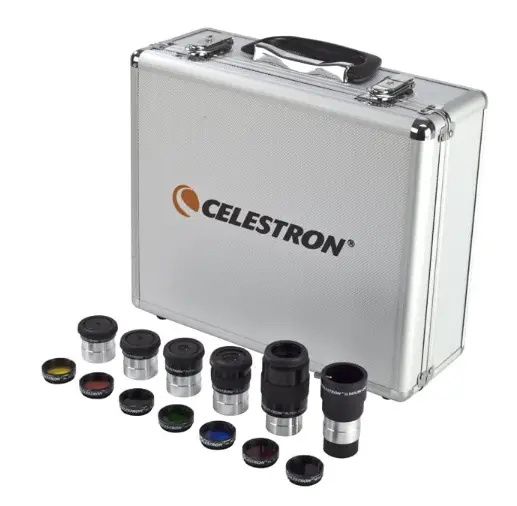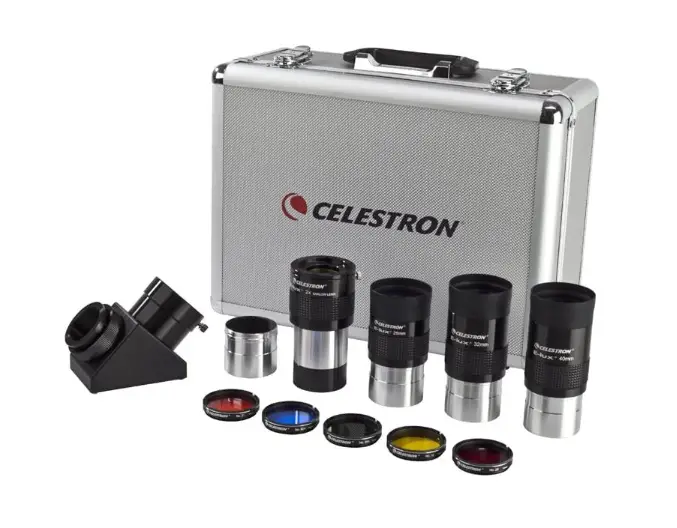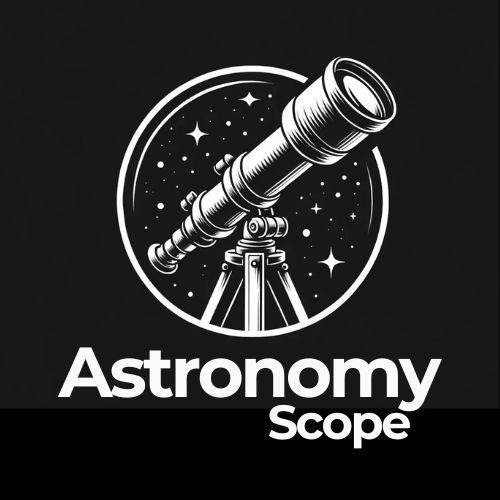I fondly remember when I was first getting into astronomy. I was plagued with questions. Especially around eyepieces.
One of the first ones I remember having, was this: “Which is better, a 1.25-inch or 2-inch eyepiece?”
It’s a question I often see. So I would like to share my thoughts and opinions on the topic here today.
And while the answer isn’t as straightforward as you might think, it does largely depend on what you’re looking to achieve in your observational astronomy. We’ll get into this shortly.
Nevertheless, this article aims to clarify the differences between these two types of eyepieces, dissecting their pros and cons, and, hopefully, helping you make an informed decision for your next purchase!
My Recommended 1.25″ Eyepiece Kit

My Recommended 2″ Eyepiece Kit

Understanding the Basics
Before we delve into the specifics, it’s important to understand what an eyepiece is and its significance in an astronomical telescope.
Simply put, the eyepiece is the component of the telescope that you look through to see objects. It’s a crucial part because it magnifies the image collected by the telescope’s primary lens or mirror.
What Is The Difference Between 1.25″ and 2″ Eyepieces?
The primary difference between a 1.25-inch and 2-inch eyepiece is the diameter of the barrel, with the 2-inch eyepiece being three-quarters of an inch larger.
But what does this mean for you, the observer?
Field of View and Magnification
Typically, 2-inch eyepieces are used for lower magnification and/or wider field of view.
The larger barrel size of a 2-inch eyepiece allows for a wider Apparent Field Of View (AFOV) through the eyepiece than a 1.25-inch.
In practical terms, if you had a 2-inch and a 1.25-inch 32mm eyepiece, the AFOV in the 2-inch eyepiece would be greater, possibly substantially so.
Lens Elements and Eye Relief
The 2-inch eyepiece also allows for larger lens elements.
This means that even at higher magnifications or short focal lengths, you’re not looking through a “peep hole,” as you would with a standard 1.25-inch Plossl eyepiece.
You could be viewing through an eye lens that is 1.25-inches in diameter even in short focal length eyepieces.
This is a significant advantage as it can make the observation experience much more comfortable.
Additionally, many 2-inch eyepieces offer better eye relief, meaning you don’t have to have your eye as close to the eyepiece, enhancing the comfort during prolonged observations.
The Price Difference
One of the most noticeable differences between 1.25″ and 2″ eyepieces is the cost.
With the additional benefits that 2″ eyepieces offer, it is only natural that they come at a higher price.
However, it’s crucial to remember that the investment might be worth it, considering the enhanced field of view, the increased comfort, and the better overall experience that a 2″ eyepiece offers.
The Advantage of a 1.25″ Eyepiece
It’s essential to remember that the smaller 1.25″ eyepiece has its own distinct advantages.
Just as not all astronomical observations require a wide field of view or low magnification, not all situations demand a 2″ eyepiece.
Let’s explore some of the perks of the 1.25″ eyepiece.
Affordability
A key advantage of 1.25″ eyepieces is their cost-effectiveness.
For budding astronomers or those with budget constraints, 1.25″ eyepieces offer an affordable way to venture into the world of observational astronomy.
They provide good performance without causing a significant dent in your wallet.
Compatibility
Most telescopes, especially beginner and intermediate models, are designed to work with 1.25″ eyepieces, making them highly compatible and easy to use.
While you can use adapters to fit 2″ eyepieces to these telescopes, it’s often more convenient to use an eyepiece designed for your telescope’s specifications.
Variety
The 1.25″ eyepiece format has been around for a long time and is widely used.
This has resulted in a vast variety of 1.25″ eyepieces being available on the market, giving you plenty of options in terms of design, focal length, and manufacturer.
Whether you’re looking for a wide field eyepiece for deep sky observations or a high power eyepiece for planetary viewing, you’re likely to find a 1.25″ eyepiece that suits your needs.
Portability
In comparison to their 2″ counterparts, 1.25″ eyepieces are significantly more compact and lightweight.
This can be an important factor if you plan to travel with your telescope or if you have to carry your equipment over long distances to your observing site.
High Magnification Viewing
While 2″ eyepieces are great for wide field, low power views, 1.25″ eyepieces excel when it comes to high power, narrower field views.
They are often the preferred choice when observing planets, the Moon, or other small, bright objects where a high level of detail is desired.
The Advantage of a 2″ Eyepiece
We’ve discussed the merits of a 1.25″ eyepiece, but what about its larger counterpart, the 2″ eyepiece?
Let’s delve into the distinct advantages that 2″ eyepieces have to offer.
Wide Field of View
One of the key advantages of 2″ eyepieces is their ability to provide a wider field of view.
This feature is particularly valuable when observing expansive celestial objects or fields, such as large nebulae, star clusters, or wide areas of the Milky Way.
The larger Apparent Field Of View (AFOV) that 2″ eyepieces offer can significantly enhance your astronomical observations.
Enhanced Comfort
Another perk of 2″ eyepieces is the enhanced comfort they offer.
Their larger lens elements mean you’re not peering through a small peephole, even at high magnifications.
Plus, they tend to offer more generous eye relief, meaning your eye doesn’t have to be as close to the eyepiece.
This feature can make long nights of stargazing much more enjoyable and less tiring.
Improved Light Gathering
Due to their larger size, 2″ eyepieces can incorporate larger lens elements, which have the ability to gather more light.
This can result in brighter and more detailed images, especially when observing faint deep-sky objects.
The ‘Wow’ Factor
Last but not least, the immersive viewing experience offered by a 2″ eyepiece is hard to match.
The wide field of view can give you a sense of floating in space or being part of the celestial sphere, which is a feeling that many astronomers find hard to resist.
Things To Consider When Choosing Between 1.25 and 2″ Eyepieces
Choosing the right eyepiece for your telescope can feel like a daunting task, given the variety of options available. Here are some key factors to consider when deciding between 1.25″ and 2″ eyepieces:
What Are You Planning to Observe?
Your observational targets play a significant role in deciding the type of eyepiece you should choose.
If you are more interested in viewing wide areas of the night sky, observing larger nebulae, or simply want a wider field of view, a 2″ eyepiece may be the better choice.
Conversely, if you’re more interested in observing smaller, more detailed objects such as planets or specific features on the moon, a 1.25″ eyepiece could serve you well.
What Is Your Telescope’s Capability?
Not all telescopes can accommodate 2″ eyepieces.
Be sure to check your telescope’s specifications.
If your telescope’s focuser is designed for 1.25″ eyepieces, you would need an adapter to use a 2″ eyepiece, and even then, the performance may not be optimal.
Consider Your Budget
As we’ve discussed earlier, 2″ eyepieces are generally more expensive than 1.25″ eyepieces.
If you’re working within a tight budget or just starting out in astronomy, the affordability of 1.25″ eyepieces might be more appealing.
Think About Comfort
Observing comfort is an essential aspect to consider.
If you’re planning on long viewing sessions, a 2″ eyepiece with its wider lens and more generous eye relief could make your experience more comfortable and enjoyable.
Do You Want To Travel?
If you frequently travel with your equipment, the size and weight of your eyepieces could be a consideration.
In this case, the more compact and lightweight 1.25″ eyepieces may have an advantage.
The Rest Of Your Eyepiece Collection
Finally, consider how the new eyepiece will fit into your existing eyepiece collection.
If you already have a range of 1.25″ eyepieces covering different focal lengths and are satisfied with the views they provide, sticking with 1.25″ eyepieces may make more sense.
However, if you’re looking to expand your observing capabilities, adding a 2″ eyepiece might be a valuable upgrade.
Final Thoughts
In the end, the choice between a 1.25″ and a 2″ eyepiece comes down to personal preference, the specific needs of your observational journey, and what you value most in your stargazing experiences.
Both eyepiece sizes have their unique benefits: 1.25″ eyepieces tend to be more affordable and compatible with a variety of telescopes, while 2″ eyepieces offer a wider field of view, greater comfort, and a more immersive viewing experience.
Understanding these differences and considering your observing targets, budget, comfort, and telescope capabilities can guide you towards the eyepiece that will best enhance your love for astronomy.
Remember, there’s no ‘wrong’ choice – the cosmos is waiting to be explored, no matter what eyepiece you use.
Related guides you may want to read:
- 10mm vs 20mm Eyepiece
- Best Telescope Eyepiece for Viewing Planets
- Celestron Luminos Review
- Best Eyepiece For Celestron 8SE

Hey, my name is Jeremy. I’m a passionate and seasoned astronomer who loves nothing more than observing the night sky. I also love researching, learning, and writing all things Space and the Universe. I created Astronomy Scope to share my knowledge, experience, suggestions, and recommendations of what I have learned along the way while helping anyone to get into and maximize their enjoyment of the hobby.

